The Distance Formula
Suppose A is  and B is
and B is 
The distance between points A and B is given by the following formula.

Example: Find the y-coordinate of the points that are 5 units away from the point (3,3) that have an x-coordinate of -1.



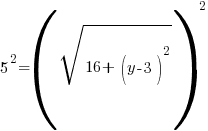






 or
or 
 or
or 
The Distance Formula
Suppose A is  and B is
and B is 
The distance between points A and B is given by the following formula.

Example: Find the y-coordinate of the points that are 5 units away from the point (3,3) that have an x-coordinate of -1.










 or
or 
 or
or 
The Distance Formula
Suppose A is  and B is
and B is 
The distance between points A and B is given by the following formula.

Example: Find the distance between points A and B.
Point A is  and point B is
and point B is 






The Midpoint Formula
Suppose A is  and B is
and B is 
The midpoint of the line segment joining points A and B is given by the following formula.

Example: Find the midpoint of a line segment joining points A and B.
Point A is  and point B is
and point B is 
The x coordinate of the midpoint can be found by averaging the x-values of point A and B. The y-coordinate of the midpoint can be found by averaging the y-values of point A and B.



Plotting Points Method
Example: Graph  by the plotting points method.
by the plotting points method.
1. Find ordered pair solutions. We can organize this information in a table.
When the equation is written in “y=” format it is easier to choose values for x and then find the y’s. Although you are allowed to choose any x values, for this table I have used a standard set of x’s so that we have a variety. Some negatives, some positives and zeros.
To find the y’s substitute the value of x into the equation and simplify to find y.
2. Plot the ordered pair solutions
Using the table above we have 5 ordered pairs 
Plot the ordered pairs using the rectangular coordinate system.
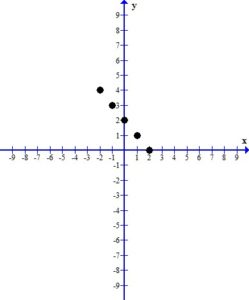
3. Draw the line or curve that connects the ordered pairs.
When you look at the plotted ordered pairs you should see a pattern the that points make. As I discussed in a previous post, most absolute value graphs form a “v” shape. It seems I am not graphing the portion of the graph that shows the “v” shape. With the plotting points method all I can do is find more ordered pairs to try to get the correct graph. However, in a future post, we will discuss other graphing methods give us more information about where the interesting part of the graph is.
In the mean time, to finish this graph I need just one more ordered pair.  which I get from plugging three into the equation for x.
which I get from plugging three into the equation for x.
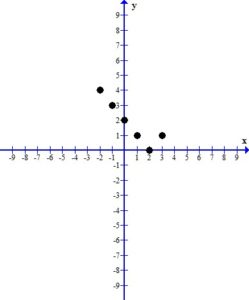
This makes the graph have the “v” shape we expected.
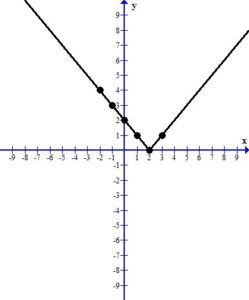
The line represents all of the ordered pairs that are solutions to the equation  .
.
Plotting Points Method
Example: Graph  by the plotting points method.
by the plotting points method.
1. Find ordered pair solutions. We can organize this information in a table.
When the equation is written in “y=” format it is easier to choose values for x and then find the y’s. Although you are allowed to choose any x values, for this table I have used a standard set of x’s so that we have a variety. Some negatives, some positives and zeros.
To find the y’s substitute the value of x into the equation and simplify to find y.
2. Plot the ordered pair solutions
Using the table above we have 5 ordered pairs 
Plot the ordered pairs using the rectangular coordinate system.
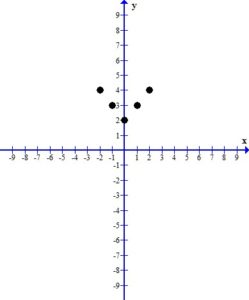
3. Draw the line or curve that connects the ordered pairs.
When you look at the plotted ordered pairs you should see a pattern the that points make. In this case, the points form a “v” shaped graph. Most of the equations with absolute value have graphs of this shape.

The line represents all of the ordered pairs that are solutions to the equation  .
.
Plotting Points Method
Example: Graph  by the plotting points method.
by the plotting points method.
1. Find ordered pair solutions. We can organize this information in a table.
When the equation is written in “y=” format it is easier to choose values for x and then find the y’s. Although you are allowed to choose any x values, for this table I have used a standard set of x’s so that we have a variety. Some negatives, some positives and zeros.
To find the y’s substitute the value of x into the equation and simplify to find y.
2. Plot the ordered pair solutions
Using the table above we have 5 ordered pairs 
Plot the ordered pairs using the rectangular coordinate system.
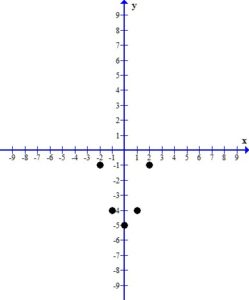
3. Draw the line or curve that connects the ordered pairs.
When you look at the plotted ordered pairs you should see a pattern the that points make. In this case, the points form a “u” shaped curve called a parabola. Most of the equations with x squared have graphs of this shape.

The line represents all of the ordered pairs that are solutions to the equation  .
.
Here is a youtube video with a similar example.
Plotting Points Method
Example: Graph  by the plotting points method.
by the plotting points method.
1. Find ordered pair solutions. We can organize this information in a table.
When the equation is written in “y=” format it is easier to choose values for x and then find the y’s. For this table I will choose multiples of the denominator so that my ordered pairs are all integers.
To find the y’s substitute the value of x into the equation and simplify to find y.
2. Plot the ordered pair solutions
Using the table above we have 5 ordered pairs 
Plot the ordered pairs using the rectangular coordinate system.

3. Draw the line or curve that connects the ordered pairs.
When you look at the plotted ordered pairs you should see a pattern the that points make. In this case, the points form a straight line.

The line represents all of the ordered pairs that are solutions to the equation  .
.
Here is a youtube video with a similar example.
Plotting Points Method
Example: Graph  by the plotting points method.
by the plotting points method.
1. Find ordered pair solutions. We can organize this information in a table.
When the equation is written in “y=” format it is easier to choose values for x and then find the y’s. Although you are allowed to choose any x values, for this table I have used a standard set of x’s so that we have a variety. Some negatives, some positives and zeros.
To find the y’s substitute the value of x into the equation and simplify to find y.
2. Plot the ordered pair solutions
Using the table above we have 5 ordered pairs 
Plot the ordered pairs using the rectangular coordinate system.
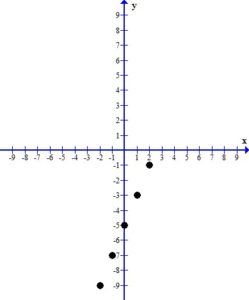
3. Draw the line or curve that connects the ordered pairs.
When you look at the plotted ordered pairs you should see a pattern the that points make. In this case, the points form a straight line.

The line represents all of the ordered pairs that are solutions to the equation  .
.
Here is a youtube video with a similar example